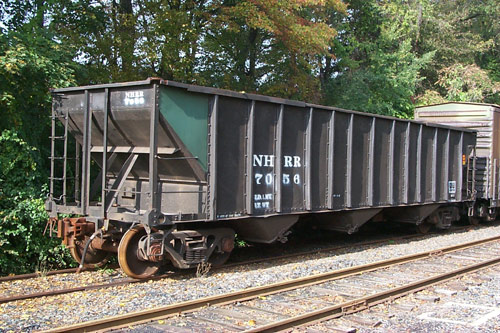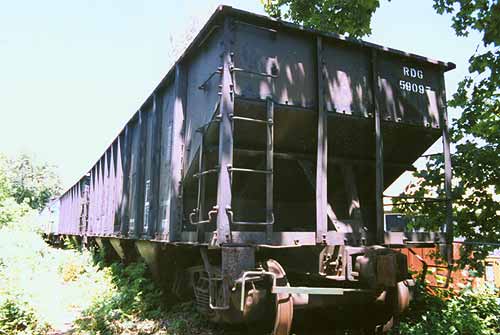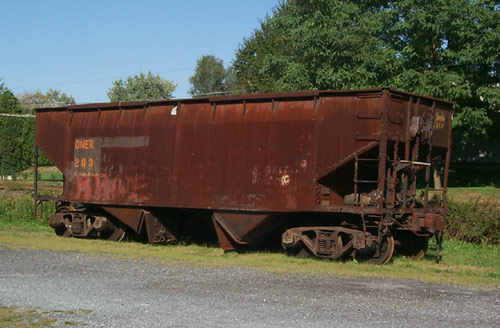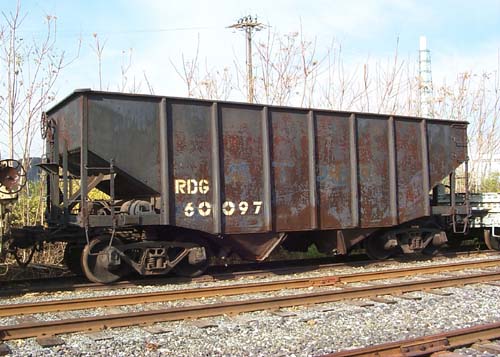RDG Co., 90-ton, 3-Bay Hopper Car, Class HTz, #40074, #40150

#40150 at Temple, PA, date unknown. (photo courtesy Charles Murphy, Jr., MP&RE collection)
Built by Bethlehem Steel in 1962, these were part of a group of 400 cars originally stenciled for Ore Service Between Joanna, Cornwall and Bethlehem, but eventually were used in coal service also. Both will be restored to Speed lettering. #40074 was purchased from Conrail in the early 90’s, while #40150 was donated by the Reading & Northern in 2002.
RDG Co., 70-ton, 3-Bay Hopper Car, HTf, #59061, #59097

#59097 and #59061, north of Reading, June 1993. (photo courtesy John Caples)
Several months prior to the formation of Conrail, the Reading Company constructed their final group of hoppers–or any freight car for that matter–in their famed Reading Car Shops. The HTg hoppers were assembled from prefabricated kits supplied by Bethlehem Steel Car. These 45-foot, 12-panel, triple-bay hoppers had a cubic capacity of 3,487' and rode on flat-top Barber S-2 trucks with 36" wheels.
Unlike the other hoppers that the Reading had constructed in their shops during the 1970s, the HTg class did not have the famed Reading “speed lettering” scheme. Actually, they had no paint scheme in the true sense of the word. Only extra-large RDG reporting marks adorned the hoppers, a design elegant in its simplicity. The cars were assigned to the series RDG 483501-484600 and remained in the same series under Conrail, with CR replacing the RDG. A word of note about the CR series is in order since Conrail, as they so often did, mixed a few other classes into the series, making it almost impossible to figure out which cars were actually HTg’s.
Like their smaller capacity cousin, the HTe, the HTg’s were originally assigned to iron ore service between Bethlehem Steel’s high-grade ore mine in Joanna, PA, on the Reading Company’s old Wilmington & Northern Branch and the steel plants in Bethlehem. The HTg’s were also placed into regular coal train service under both the Reading and Conrail.
Over 800 of these cars survived into the mid-1990s still in original Reading Company numbers and paint, a reminder of Northeastern railroading prior to the Conrail era.
RDG Co., 50-ton, 2-Bay Side Hopper Car, Class HTc, #63321

#63321, north of Reading, date unknown. (photo courtesy Charles Murphy, Jr., MP&RE collection)
In 2002, we took delivery of what may be the last Reading Railroad offset-side, 55-ton capacity hopper car in existence. The Reading once owned well over 6000 of this style car, and #63321 was one of 1800 reconditioned in the late 1960s from earlier HTt, HTu & HTv class cars, which were originally built between 1948 and 1957. The Society purchased an Amtrak ballast hopper, which was traded to a shortline in upstate New York for this car.
RDG Co., 50-ton, 2-Bay Hopper Car, Class HTss, #66418

At Temple, PA, 1998. (photo courtesy Charles Murphy, Jr., MP&RE collection)
One of very few surviving cars built as composite (steel with wood sides) car during WWII to conserve steel. 50-ton, 2-bay design. In 1951 efforts were made to convert this class to all steel construction. #60097 was applied before the actual number was determined.*[2]
| Notes: | |
|---|---|
| *1 (info courtesy Conrail Cyclopedia) *2 (info courtesy RDG Color Guide to Freight and Passenger Equipment by Craig T. Bossler) |
(last updated: 4/03) |